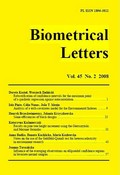
Biometrical Letters vol. 45(2), 2008, pp. 9-22


|
ANALYSIS OF A WITH-COVARIATES MODEL FOR THE ENVIRONMENTAL INDEXES
I. Pinto1, C. Nunes2, J.T. Mexia3 1Instituto Superior de Engenharia de Lisboa, Rua Conselheiro Emdio Navarro 1, 1959-007 Lisboa, Portugal: e-mail: ipinto@deetc.isel.ipl.pt 2Universidade da Beira Interior, Covilha, Portugal 3Faculdade de Ciencias e Tecnologia, Universidade Nova de Lisboa, Monte da Caparica, Portugal |

In the context of the use of Joint Regression Analysis (JRA) for cultivars comparison, as in Pinto (2006), the environmental index is a variable which measures the productivity per block in field experiments. Initially, randomized blocks were used, and their mean yields (classical environmental indexes) were taken as measuring their environmental indexes. Later on, following Patterson and Williams (1976), alfa - designs, which have incomplete blocks, superseded randomized blocks. Then the environmental indexes for each block, couldn't be measured by the respective mean yields, which would lead to biased estimates. This problem was solved by the introduction of L2 environmental indexes see Mexia et al. (1999). In that paper the authors, through the application of a Zig-Zag algorithm, showed how to adjust simultaneously the regression coefficients and the environmental indexes. This study presents an analysis of a with-covariates model for the Environmental Indexes (see Searle, 1987) using the adjusted L2 environmental indexes as observations of the dependent variable. Concerning the explicative variables, we consider a general mean, the main effects of two qualitative factors, year and location and as covariates the "classical environmental indexes". The presence of multi-collinearity led to the use of principal components, see Judge et al. (1988), to perform the adjustment. Our results are applied to the data of a Wheat Plant Breeding Program in Portugal (1986-2000), kindly supplied by the Portuguese Plant Breeding Station. The sole significant result was for the covariate, which validates the linearity assumed in JRA.

linear models, covariates, dummy variables, multicollinearity, principal components, L2 environmental indexes, JRA.
